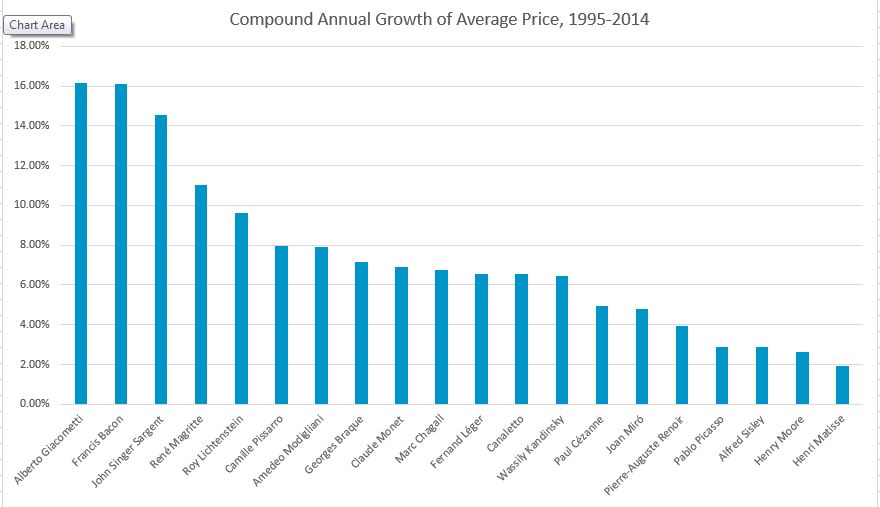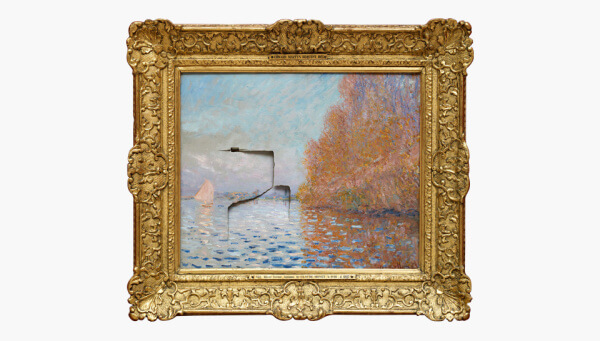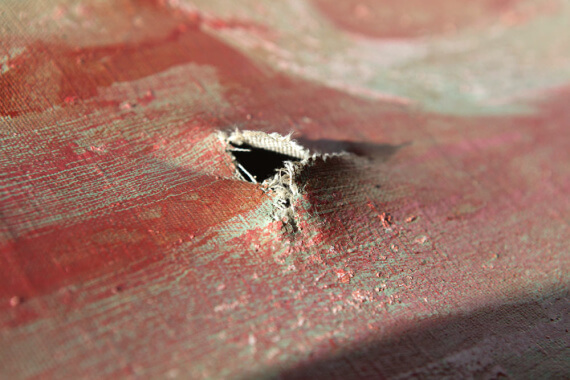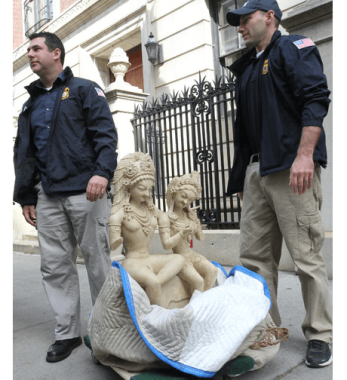Commentary
Stars Rise, Stars Set
The art market, in descent, reveals stars both rising and falling. Evening auctions are always great aids at understanding trajectory, and those of Sotheby’s and Christie’s London, in early October, were especially so.
At Christie’s October 4 sale, 31 works from a total auction of 56 were either bought in or sold at or very close to the low estimates or on guarantees. Sotheby’s did somewhat better with 27 out of 67 works bought in or sold at or very close to the low estimates or on guarantees.
FALLING STARS:
Andy Warhol, after having commanded the highest sales records for years, was virtually excluded from the London sales. Sotheby’s had one modest work for sale, Joseph Beuys (Diamond Dust), which eked past its low estimate, whilst Christie’s locked the artist out for the night. Warhol’s market, both private and auction, has been quiet—one could almost say moribund—during
the last 18 months or so.
Christopher Wool sold one picture on a guarantee and a buy-in at Sotheby’s. He also experienced a buy-in at Christie’s.
Mark Grotjahn, the decorative artist whose remarkable rise was fueled by less sophisticated “pretty painting” buyers, found only one place at auction at Christie’s. No bids were evident, other than the house bids: another buy-in.
Rudolf Stingel suffered a double buy-in at Christie’s and hit a single buy-in at Sotheby’s, scoring a negative three for three. Decorative art seems on the outs these days.
Lucio Fontana had a slash painting at Sotheby’s (yes, another buy-in) and another at Christie’s, where it squeaked by and into a buyer’s hands.
Gerhard Richter’s Skull was dead in the water, while a modest painting sold on the guarantee at Christie’s. Sotheby’s left Richter out of the sale; the artist’s market has been trending lower for the last few months, with this auction sealing the coffin.
RISING STARS:
Jenny Saville at Sotheby’s set a new record for a living woman artist: £9.5 million in a £3.0-£4.0 estimate.
Kaws won a big price for a big image at Sotheby’s: £1,030,000 against £250,000–£350,000 estimate.
Albert Oehlen doubled to tripled estimates at Christie’s but had no pictures at Sotheby’s.
IN CONCLUSION:
Nothing is forever. The stars of yesterday sometimes fade in the night, sometimes reilluminate. When the market enters round two, rebound, art sought for quality rather than price progression or style will again be in the winner’s circle. Recognition by price is always short-lived. For success, look at the art, not the price.
There is more than psychic return on investment in this. If you look and learn, you’ll be buying more than décor. You will see greatness sooner than others and then you’ll profit twice.
UncategorizedFeb 26th, 20190 comments
Better Practices on Art Insurance
As a consignor:
1) Best to include a clause holding the consignee responsible for damage or loss should his/her insurance company fail to settle any claim within 45 days.
2) Make sure the consignor is additional insured and loss payee.
3) The Certificate of Insurance should be committed by the issuer and not simply informational.
4) READ THE ENTIRE POLICY or have your attorney do so. Know the exceptions which may, effectually, rob you of insurance should the work(s) be damaged or lost.
5) Know the insurance company you are dealing with as certain ones continuously seek reasons for nonpayment or endless delay.
6) Be sure, in the case of damage or loss, you notify your own insurance company, the consignee, and the consignee’s insurance company on a timely basis.
7) Should coverage not be extended for any reason, be sure to read the fine print as to when legal action may be commenced. DON’T MISS THE DATE.
We are compiling both anecdotal and history of various insurance companies’ responsiveness and willingness to live up to their responsibilities. Please forward any information of interest you may have to us at info@artassure.com.
Art Law Art Market ResearchJul 26th, 20160 comments
Improper Practices Part II
Yesterday’s note on practices in the art market brought forth a slew of comments and suggestions for publication. We have vetted and two of them and will convey them on to you here.
1) An invoice, not objected to within 30 days by the recipient is deemed to be accepted and becomes a contractual obligation to pay. Buyers, beware of contested invoices going uncontested for more than thirty days.
2) When shipping valuable items with one’s shipper, do not waive any claims of damage to the works while in the hands of the shipper unless you have obtained, in writing, permission for the waiver from your insurer. Failure to do so is cause for the insurance company to deny coverage on damage and, in fact, cancel the policy.
As the art business has grown, the laws, as mentioned here, have the attention of the authorities and enforcement is severe – a reason the community should consult with competent counsel as to its business practices.
We would appreciate your input to our series as we develop these memorandums for the community’s benefit.
Thank you,
ArtAssure Ltd.
info@artassure.com
Art Law Art LitigationJul 22nd, 20160 comments
Improper Practices
ArtAssure Ltd. is assembling a series on common legally dangerous practices prevalent in the art market today for use by art professionals.
Art Law Art LitigationJul 21st, 20160 comments
artnet News: The Art Money 20
The attached article on artists’ increase in prices is, indeed, interesting. Though statistically it is flawed and many of the highest prices are attributable to either erroneous reporting, presales or guarantees at auction (all of which distort the upside). It is interesting to note how modestly the upper end of the art market has performed during the last 20 years.
– Asher Edelman

The Art Money 20: Which Artists Have Performed Best at Auction Since 1995?

(Source: artnet Analytics.)
Which blue chip artists have performed the best from a financial standpoint in the past two decades?
The results might surprise you. Unlike other markets, where values are tied to set parameters—think stocks and bonds—the value of art is far more subjective, not to mention influenced by so many factors all at once: fickle collector tastes; ever-shifting critical and public appreciation; condition of individual works; and of course supply and demand. Take works by Vincent van Gogh for instance, which despite having scored some of the highest prices at auction over the years, rarely actually come on the auction block. (See: Do Riches Await In the Van Gogh Market?).
Using the time period 1993-1997 as a baseline, we looked back at the artists who were already selling for more than $1 million each at auction at that time and then followed their market performance through 2015 by tracking average prices and the compound annual growth rate of average prices. Alberto Giacometti tops the list of performers (see chart above) though some of that track record may be due to recent auction activity, say in the past five years. Though the list is understandably heavy with names of Impressionist and modern artists, it also includes at least one Old Master (Canaletto) and several more contemporary names (Francis Bacon and Roy Lichtenstein). (See: The Old Masters Market Is Restoring Its Image to Make It Sexy and Canaletto, Caravaggio Fail to Sell at Christie’s Worst Old Masters Sale Since 2002.)

In 2010, Giacometti’s record vaulted to $103 million (£65 million) when Sotheby’s London sold the sculpture L’homme qui marche I (1960). The next three highest prices were all set in the years since then or right before (between 2008 to 2010), indicating that the market had been gathering considerable momentum in the past decade alone (See: $101 Million Giacometti Leads At Sotheby’s Sale).
A similar pattern of activity can be seen with Francis Bacon, where auction activity has been extremely robust in the past decade. Bacon is second on our list of best performers as viewed by compound annual growth of average price. Bacon has been a favorite of some of the newer-to-the-game über collectors of contemporary art, particularly from the Middle East and China. The record for the highest price ever achieved at auction was the $142.4 million paid for the triptych Three Studies of Lucian Freud (1969) sold at Christie’s in November 2013.
Picasso might seem to be the natural choice for first place but his market has been lofty for quite a long time now (see $140 Million Picasso at Christie’s Is World’s Most Expensive Painting at Auction). Artnet Analytics research indicates that between 1993 and 1997, 79 of Picasso’s works sold for at least $1 million each at auction. But in terms of our measure of compound growth in price performance, his name turns up at #17.
Here is the complete list ranked in order from highest to lowest:
1. Alberto Giacometti
2. Francis Bacon
3. John Singer Sargent
4. Rene Magritte
5. Roy Lichtenstein
6. Camille Pissarro
7. Amedeo Modigliani
8. Georges Braque
9. Claude Monet
10. Marc Chagall
11. Fernand Leger
12. Canaletto
13. Wassily Kandinsky
14. Paul Cezanne
15. Joan Miró
16. Pierre-Auguste Renoir
17. Pablo Picasso
18. Alfred Sisley
19. Henry Moore
20. Henri Matisse
Source: https://news.artnet.com/art-world/art-money-20-artists-performed-best-auction-since-1995-281454
Major works currently available by Joseph Cornell, Franz Kline, Francis Bacon, Roy Lichtenstein, Natalia Goncherova, Joan Mitchell, Pablo Picasso, Richard Prince, Frank Stella, Titian and Andy Warhol.
UncategorizedMar 31st, 20150 comments
Secure Art Financing in Advance of the May and November 2015 Auction Seasons
Sotheby’s, Christie’s and Phillips are busy securing auction consignments for the May 2015 and November 2015 auction sales. Should any consignor wish to arrange an advance on a sale of an individual work or an entire collection, ArtAssure stands ready to provide competitive financing at the following rates and terms:
- 50% loan to value of the collection’s auction estimate
- 10% – 15% interest per annum for collections valued at or above $500,000
- 6 months minimum term
The art finance industry is plagued by high interest rates and unreliable lenders. We relish the opportunity to provide the most transparent and competitive financial services to art market participants. For loan inquiries, please email info@artassure.com or call +212-288-8860.
Art Auctions Art LoansMar 17th, 20150 comments
The American Royalties Too (ART) Act: Will Droit de Suite be Implemented in the United States?
On February 26th, 2014, Congressman Jerrold Nadler introduced a new bill, the American Royalties Too (“ART”) Act. If signed into law it will be the first to implement resale royalty rights in the U.S. art market.
What is a resale royalty right?
A resale royalty right, or Droit de suite, entitles the author of a sculpture, a painting, or a drawing to a small percentage of the resale price of her work. It derives from the European concept of “moral rights” and is based on the idea that visual artists, unlike novelists, composers or musicians, are unable to benefit from the “successive exploitations of their works through the reproduction and sale of large quantities of each individual work” [i]. Resale royalty rights for visual artists were first granted in France, in 1920, and now exist in more than 70 countries.
Resale royalties are often implemented under similar conditions:
- The percentage of the resale price entitled to the artist is generally small (between 0.25% and 5%) and may be scaled on the resale price of the work (as in UK and France).
- There is a minimum value for artworks to be subject to resale royalties (e.g. €750 in the U.K.)
- The total amount received by the artist cannot exceed a fixed maximum for each sale (e.g. €12.500 in France and the U.K.).
- The artist’s resale royalty rights may depend on nationality and residence. The Berne Convention, for example, sets a “reciprocity principle” in the European Union: a resale right “may be claimed in a country of the [European] Union only if legislation in the country to which the author belongs so permits, and to the extent permitted by the country where this protection is claimed.” [ii] The European Law also provides royalties to artists who have lived in a European country for at least five years.
- The duration of the right may vary. The artist is generally entitled to resale royalties during her lifetime. In some countries, her heirs may also be entitled to resale royal rights for the duration of an artwork’s copyright. In general, those rights cannot be waived.
- The right may be limited to certain actors in the art market, such as auction houses, galleries, and private dealers.
The implementation of resale royalties in the United States has been subject to a lot of discussion. The first public report [iii] on Droit de suite was issued by the United States Copyright Office in 1992. It advised against U.S. implementation. Almost twenty years later, in December 2011, Congressman Jerrold Nadler (D- NY) and Senator Herb Kohl (D-WI) made a new attempt in favor of resale royalties and introduced the Equity for Visual Artists Act (EVAA) to Congress. The Copyright Office then wrote a new report, in December 2013, titled Resale Royalties: an updated analysis [iv], this time finding “no clear impediment to implementation of a resale royalty right in the United States and supports the right, as one alternative to address the disparity in treatment of artists under the copyright law”[v]. The Copyright Office also provides a list of recommendations for the good implementation of royalties. On February 26th, 2014, Jerrold Nadler, Senators Tammy Baldwin (D-WI) and Ed Markey (D-MA) introduced American Royalties Too Act (“ART”) Act, a new bill which takes into account some of the Copyright Office’s advice.
The “ART” Act
The resale royalty described in this new bill is substantially similar to other droits de suite. The American Royalties Too Act (“ART” Act) wishes to apply a 5% resale royalty rate only to sales of works of visual art sold by an important auction house, or through an online auction. Resale royalties will not apply for works sold for less than $5,000, and the maximum amount received per sale shall not exceed $35,000. The resale royalty shall be paid by the winning bidder to a visual artists’ copyright collecting society. The artists and his or her successor are entitled to the royalties for the duration of the copyright.
What impacts could this regulation have on the U.S. Art Market?
The opponents of resale royalties have two main arguments.
The first one is economic. Resale royalty rights, opponents argue, could strongly affect prices in the primary and secondary (resale) art markets. Moreover, the law may drive art sales to other countries with no resale royalty protection.
According to U.S. Copyright Office’s report, there is no proof that resale royalty rights decrease competitiveness in other markets where they’ve been implemented. For example, the United Kingdom, which has recently implemented Droit de suite, has a flourishing art market [vi]. Indeed, the royalty rate seems too small to have a decisive impact on the market and is just one small addition amongst all amounts added to the hammer price of auction house sales. Moreover, it seems unlikely that resale royalties would incent buyers to move their business to countries without those rights, as the clear international trend in favor of Droit de Suite makes them difficult to avoid. Finally, the implementation of resale royalties in the US will favor American artists abroad, as they will then be able to receive resale royalties in countries with a similar legislation.
The second argument takes an ethical and moral position. Resale royalties, some argue, will only benefit a small percentage of artists who are already well-known and successful. To this, Congressman Jerrold Nadler says the bill is not an “anti-poverty” measure, but a law about fundamental fairness and equity [vii].
Will the bill pass?
Both sides have strong arguments and support. It seems difficult to prognosticate on the bill’s chance of passing.
The American Royalty Too Act is supported by the Copyright Office, artist’s defense groups and celebrities. The Visual Artists Rights Coalition and the Artists Rights Society are lobbying in favor of the Act’s implementation [viii].
However, major auction houses such as Christies, Sotheby’s, not to mention online sales platforms such as eBay, and the Internet Association are known to be lobbying against the Act. The new bill limits the application of the right to online auctions and auction houses that sell more than $1 million in visual arts in a year. There is a concern among Major auction houses such as Sotheby’s and Christie’s that the law may push buyers toward smaller private dealers and galleries.
According to a March 23, 2014 article in the New York Times “it is now up to Representative Robert W. Goodlatte […] whether to schedule hearings on the bill. His office declined to comment, but congressional staff members and lobbyists familiar with the effort said resale royalties and other related issues are likely to get swept into the wholesale overhaul of the copyright act that Mr. Goodlatte is presiding over — a yearslong effort, by most accounts.”[ix]
— Researched and written by Julie Duperray (jduperray@artassure.com).
[i] VAGA comments for the U.S. Copyright Office, Resale Royalties: an updated analysis, December 2013, p 31
[ii] Berne Convention article 14ter (2).
[iii] U.S. Copyright Office, Droit de Suite: The Artist’s Resale Royalty, 1992, available at http://www.copyright.gov/history/droit_de_suite.pdf
[iv] U.S. Copyright Office, Resale Royalties: an updated analysis, 2013, available at http://www.copyright.gov/docs/resaleroyalty/usco-resaleroyalty.pdf
[v] United States Copyright Office, Resale Royalties: an updated analysis, December 2013, p 03
[vi] The UK art market maintained its third position in the global art market share in 2012. United States Copyright Office, Resale Royalties: an updated analysis, December 2013,p 48
[viii] COHEN Patricia, Lobbyists Set to Fight Royalty Bill for Artists, March 23, 2014, New York Times
[ix] COHEN Patricia, Lobbyists Set to Fight Royalty Bill for Artists, March 23, 2014, New York Times
Art LawApr 14th, 20140 comments
-
Recent Commentary
Recent Press
Archives
Categories



